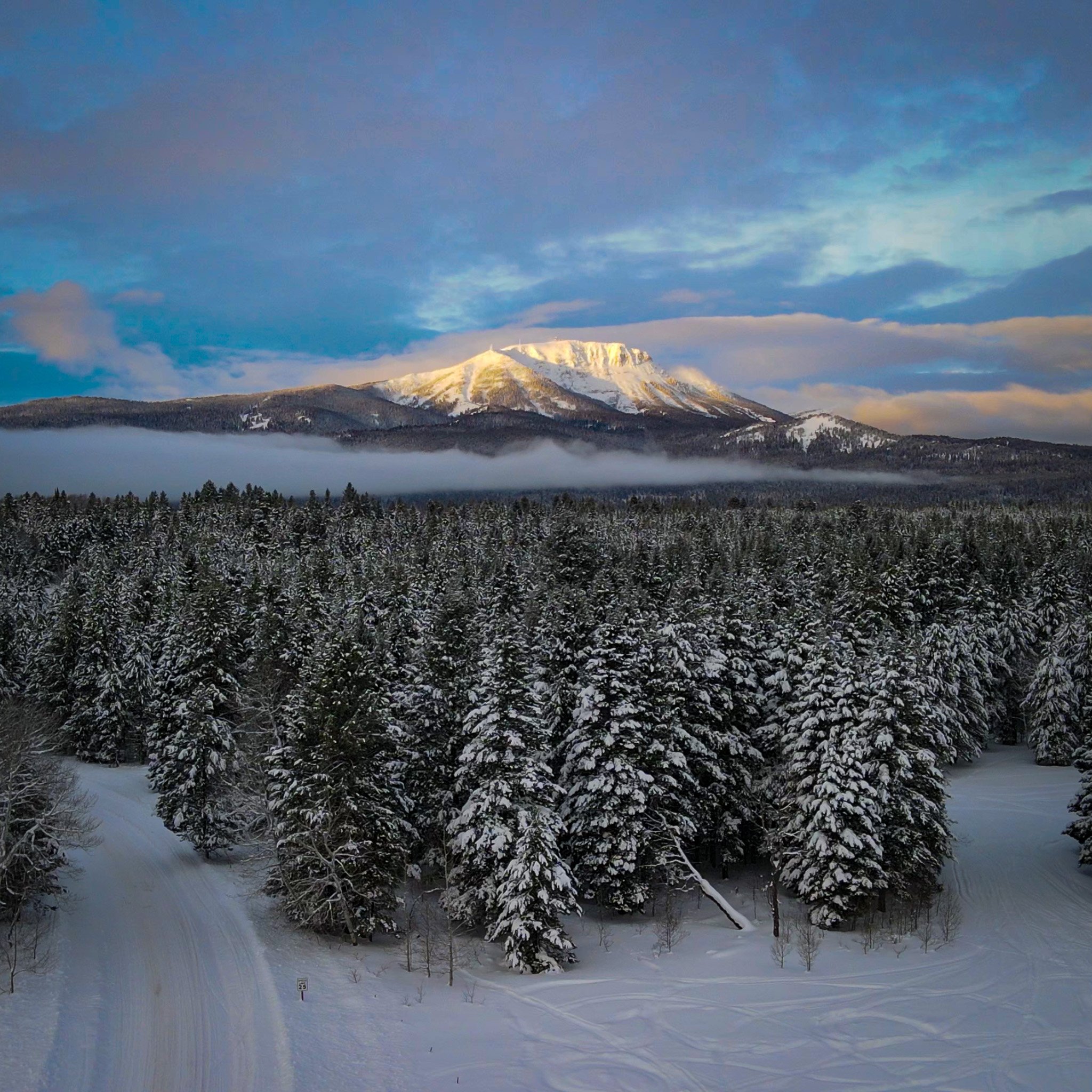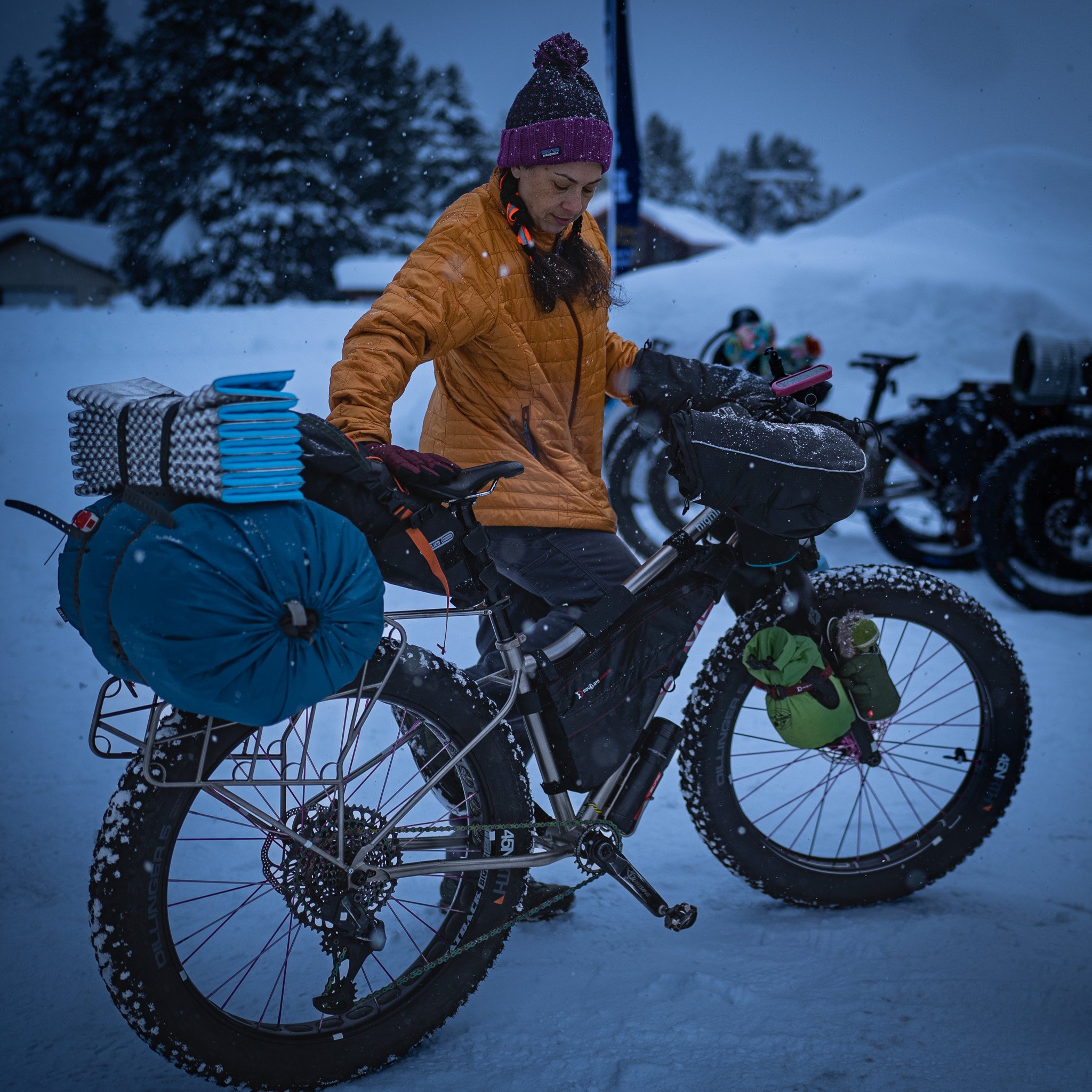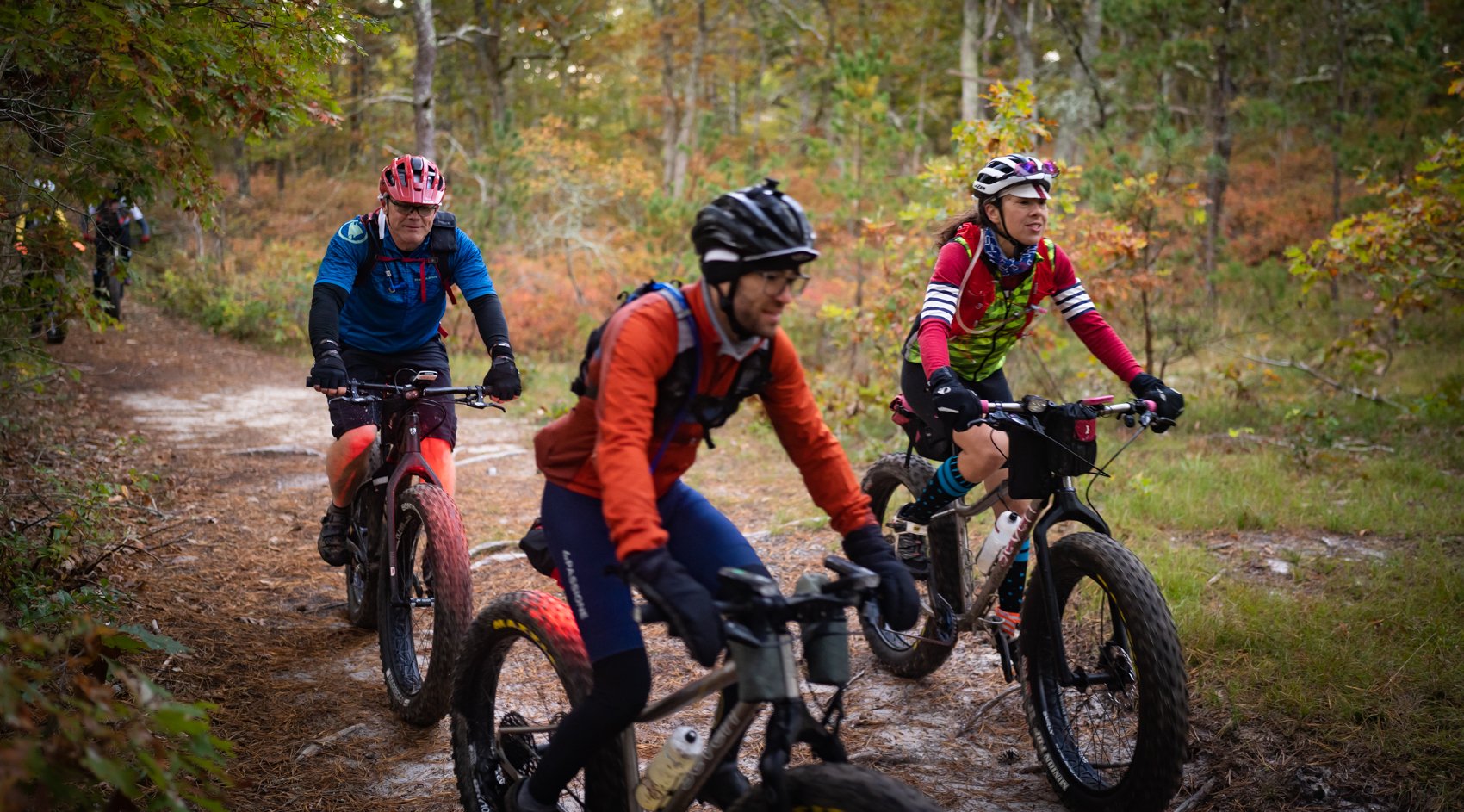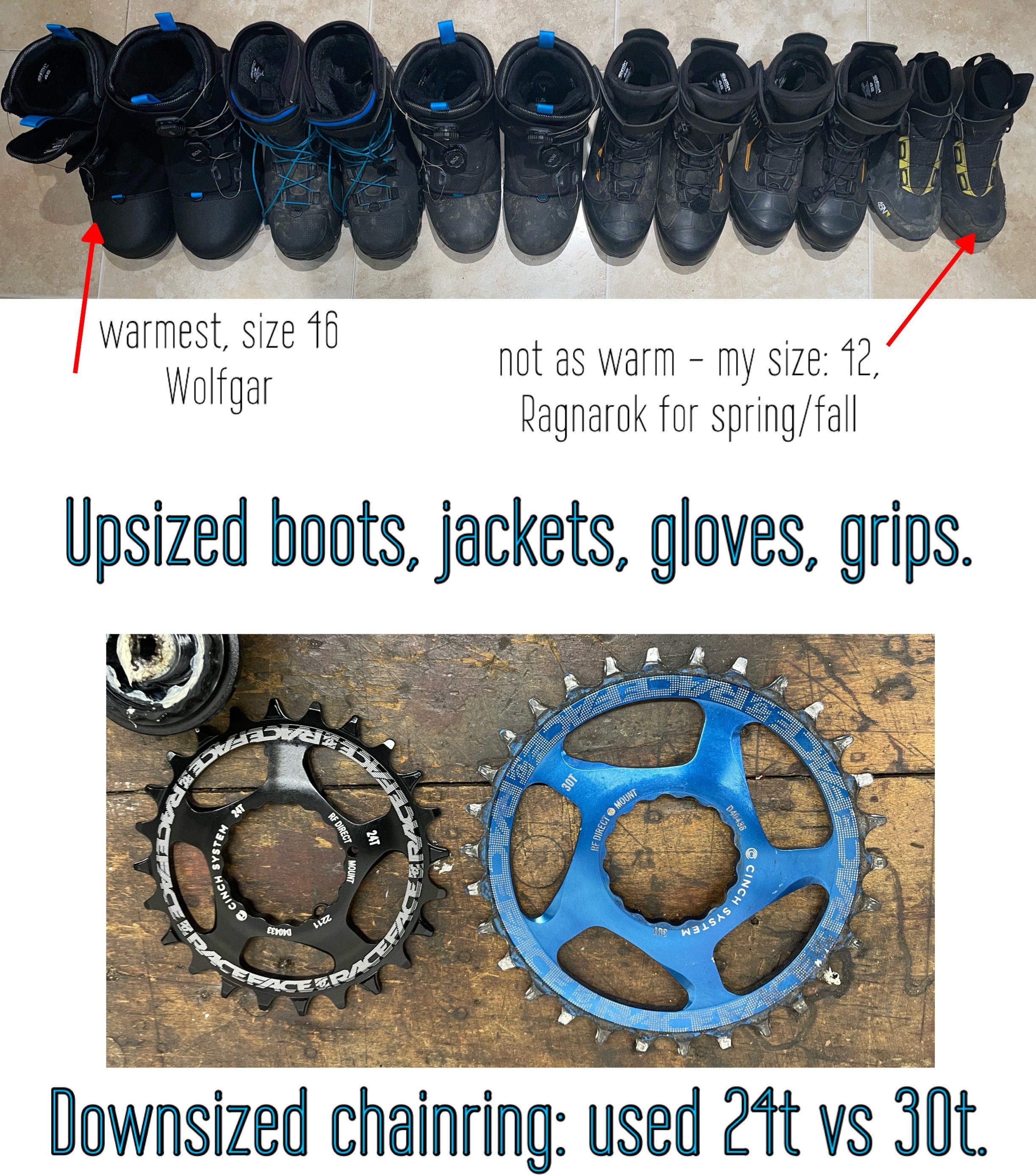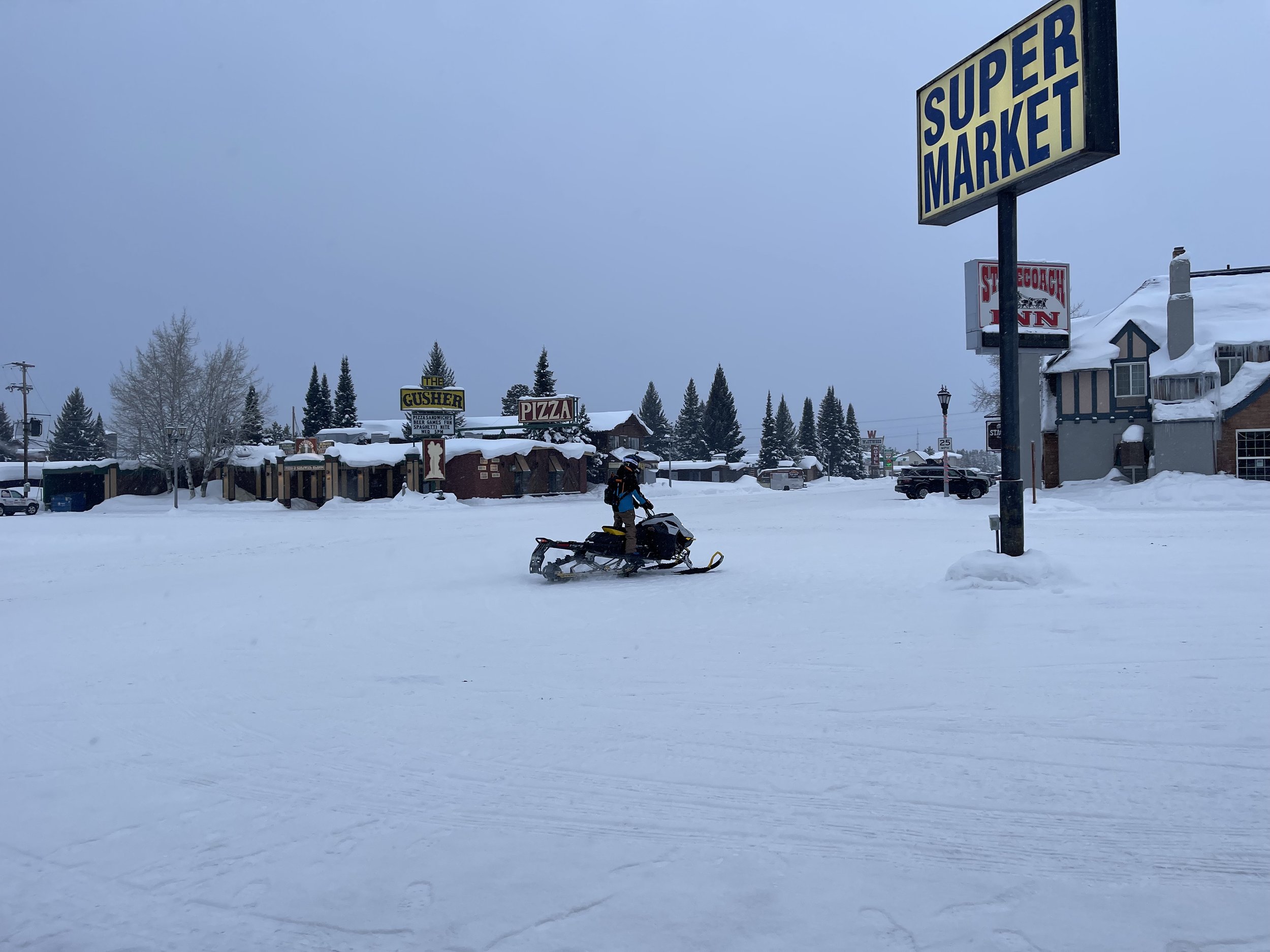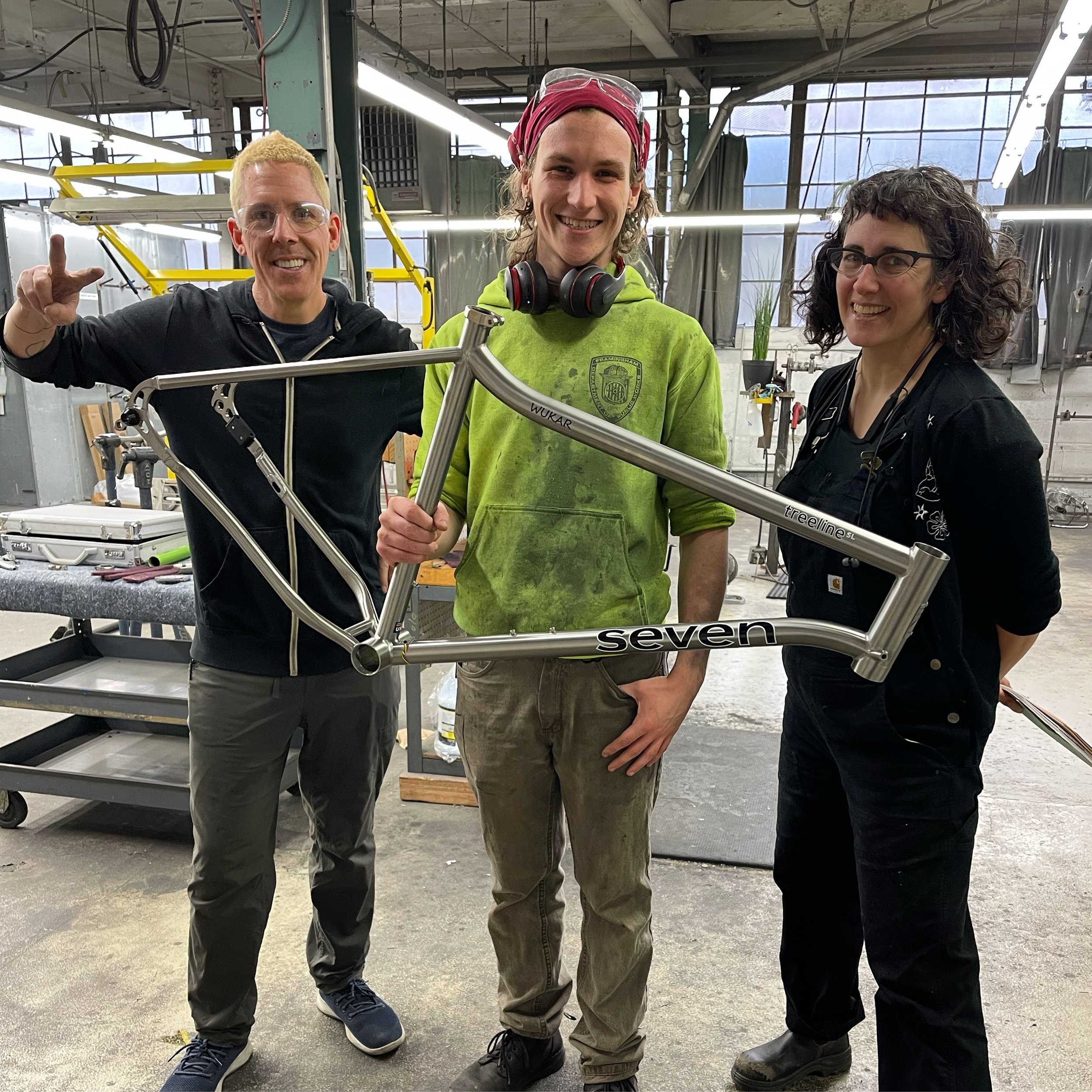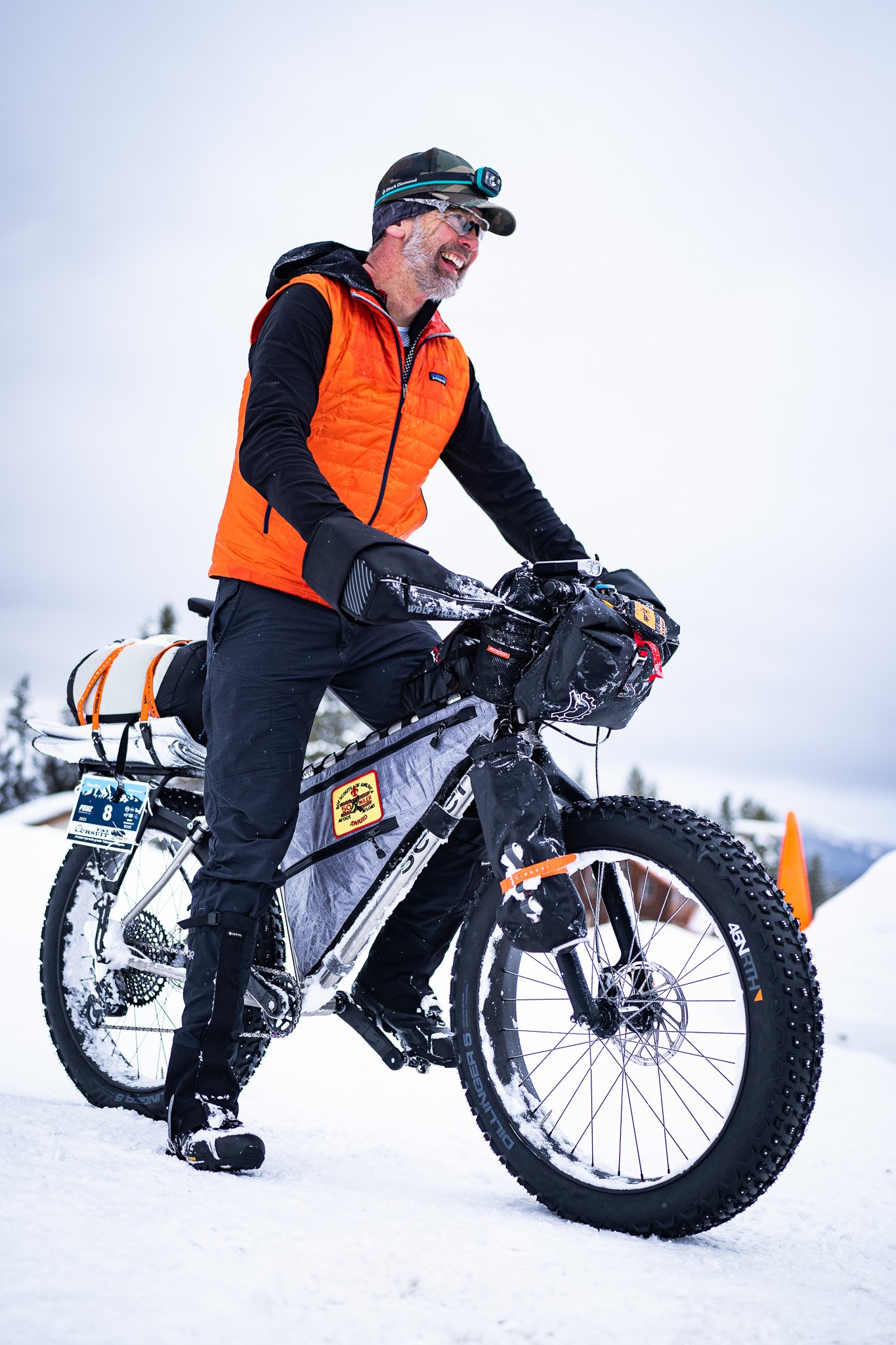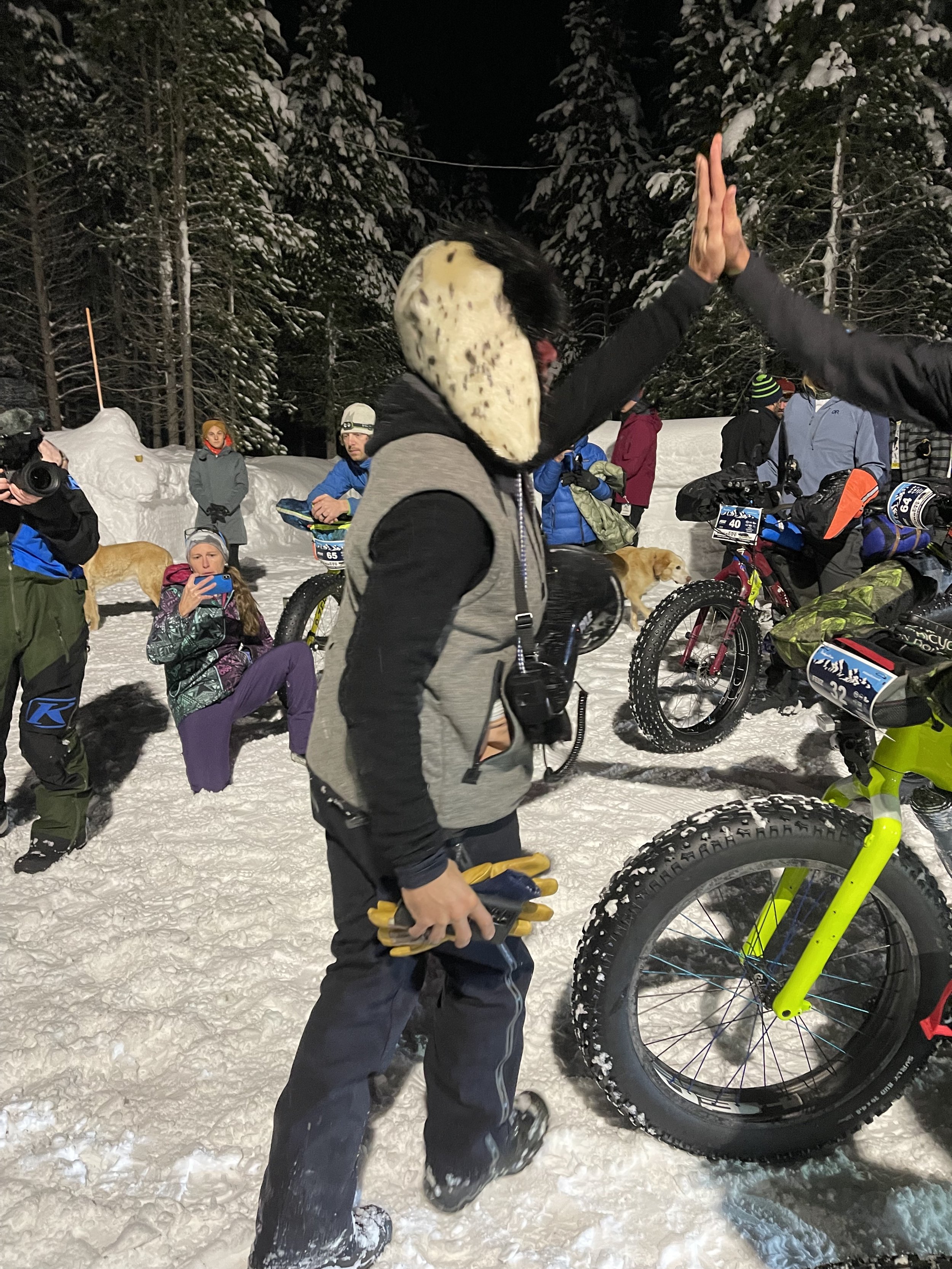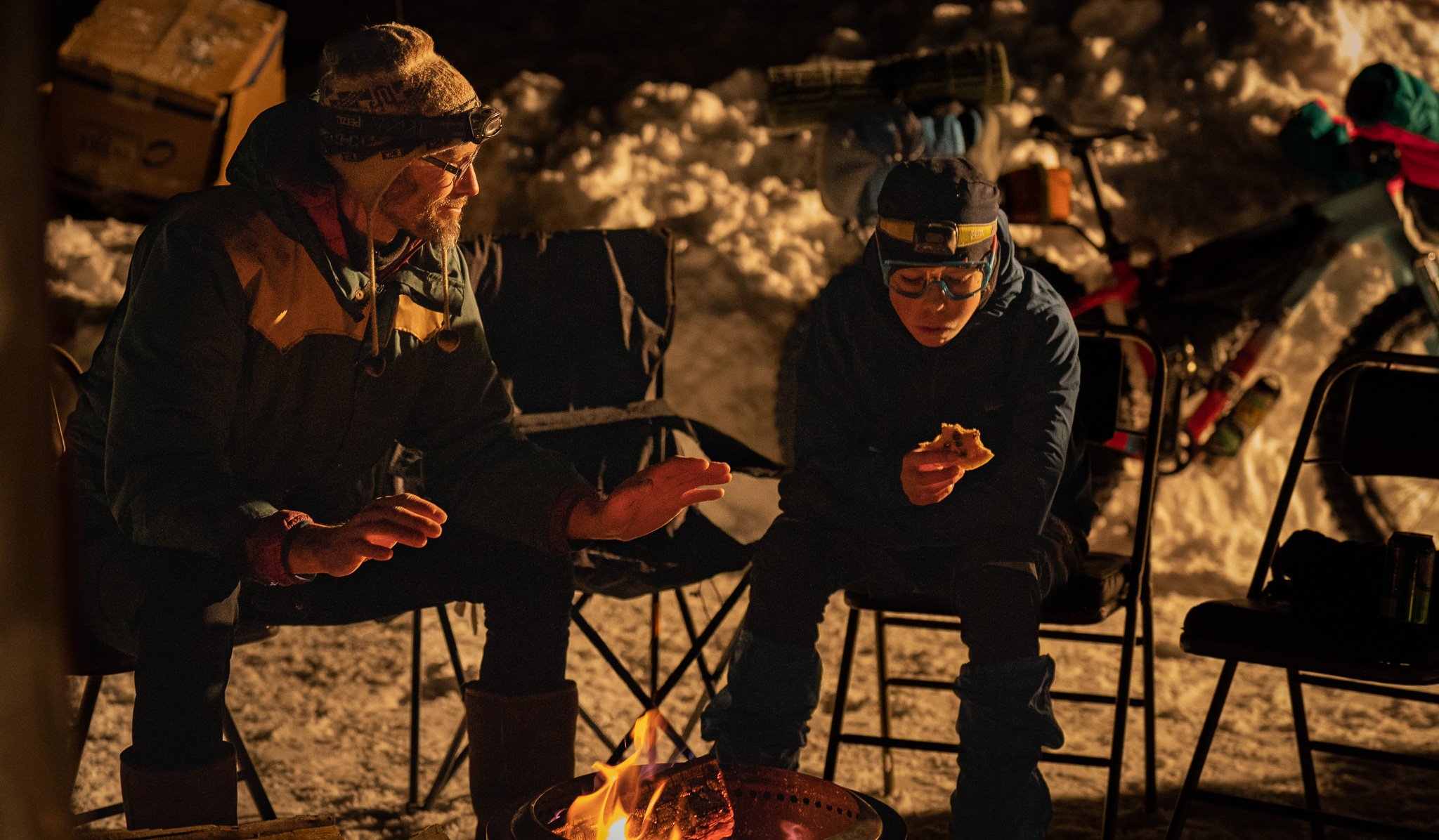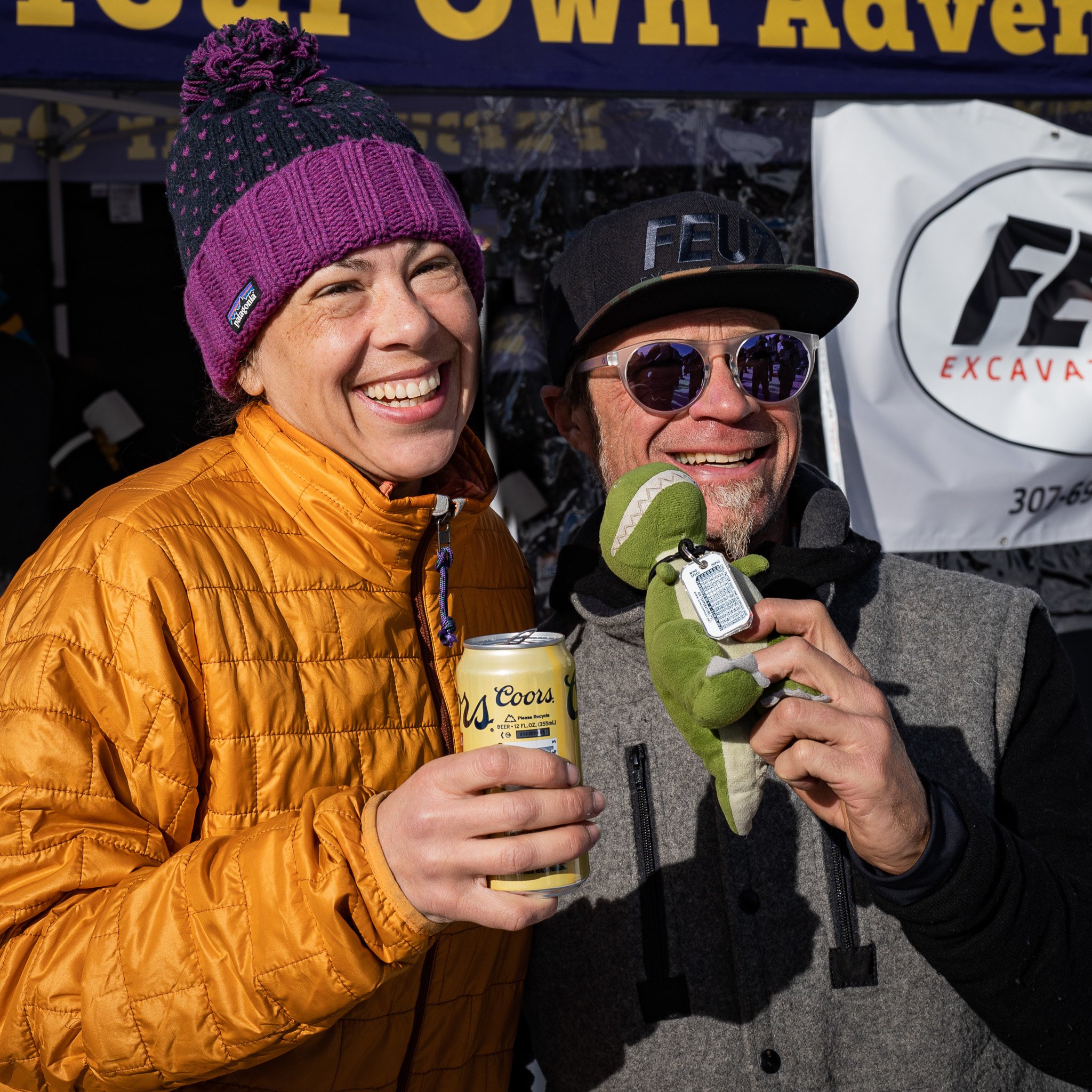by Patria Vandermark
It’s a shift in thinking that my “A” race for 2023 has already happened this year with my participation in the Fat Pursuit in Island Park, Idaho. While it’s raining and dreary outside in Massachusetts at this moment, I’m still on a post-race high, feeling healthier than I can ever remember feeling and my heart is full.
Considering it’s a mess of a weekend and there’s too much to tell, I’m offering my full story and invite you to read the part you have time to enjoy. Or just look at the photos!
This is the winter wonderland where Fat Pursuit is based in Island Park, Idaho. It’s part of the Yellowstone Ecosystem. Photo by Rob Vandermark. Most photos contained here have been provided by Rob.
The Fat Pursuit is an ultra endurance winter race in its 10th year. There are two routes: a 60k and 200km route. They run through a remote area that gets feet of snow in December every year. The promoters, renowned life-long ultra-endurance racers and advocates, Jay Petervary and Tracy Petervary, have created this event as a challenge and learning opportunity to all from those new to this world to the very best, most experienced ultra and winter athletes.
On paper, I look like an unlikely participant at Fat Pursuit. I get cold faster than most people (I’m sitting in a 70 degree house right now feeling cold, my toes are nearly numb) and I find perfect contentment with riding my gravel and road bikes. I don’t feel I need to prove anything to myself or to others, that doesn’t drive me. Why would I go to a cold, seemingly harsh environment to take on my first-ever ultra endurance event that involves making water from snow to stay hydrated and sleeping in the snow?!
As ready as I could be the night before the Fat Pursuit start.
I’m always overly anxious for Boston to get snow since it’s my very favorite landscape to ride, so traveling to an already-made winter wonderland is a nice solution to scratch my snow itch! Riding on snow makes me smile, and it is pure joy for me. Riding relatively slowly while pedaling fairly hard is warm, it’s a chance to chat with other riders, see a world blanketed in pristine flakes is always pure peace and beauty, and when I crash it means falling into a snow pile like a kid. I always giggle, even when I’m alone, when I fall into the snow. It’s simple fun without anyone taking themselves too seriously and I certainly don’t take myself seriously. A longer event means doing what I love for longer. More snow!
A good substitute for snow riding is beach riding! We’ve had to make this sub when the trails are too wet to ride, it’s allowed for quality Fat Pursuit training near Boston.
I need to be driven to train. Work has taken precedence in my life for the past 11 years. Working in the bike industry running a bike shop doesn’t allow more time on a bike, only more time near bikes. I’ve traded fitness for work, it’s the easy thing to do. I love my job so it’s simpler to work hard than train hard. The older I get, the more obvious the importance of keeping these two balanced for maintaining health into later life. Work and fulfillment from that also has a good place in there. Balance is the key.
Ride Headquarters hosted a Brutiful 100-mile fat bike ride in November which served as a great training ride and pretty spectacular day on the bike on the Cape.
I’ve learned that with some level of efficiency, one can train plenty for a huge event like this while not sacrificing work and other life commitments. I’ve found so much joy in training since these rides involve time with friends and good people, every single ride makes me feel great with after-ride endorphins, and I’ve stopped making excuses for not going out or getting on the trainer since fear of not being fit enough to get through this race is just enough motivation to get over myself when it’d be too easy to let other things distract me.
Fat Pursuit kindly helped me feel new to cycling again in a welcome way while absolutely terrifying me with its challenge.
I couldn’t believe just how much I had to learn and how many opportunities for optimization there are. Being fit is a small part of the “success” equation. Sure, the person who wins the race is very fit, but if that person brought the wrong gear, there’s no way they’re making it to the finish line. Here’s how the race went down for those at the pointy end of the competition.
Edyn, 13, was the youngest rider at Fat Pursuit. This is Edyn coming in to checkpoint 2 smiling and not all that many hours later, finish in 8th place overall. It was awesome to see him right at home at the pre-race meeting and taking on the challenge by training hard, likely better prepared than many of the adults.
As I got into researching the right gear to take, how to dress, how to bivy in the winter (sleeping in a sleeping bag contained in a bivy bag which is smaller than a tent), where to pack my stuff on the bike, etc. the more I got into it. I’ve never winter camped so there was a lot that was new for me. The research was fun! There’s no one right answer on almost any single topic. Each person gets to figure out the proper setup with no way to know what’s “right” until race day.
I ran out of time practicing bivy sleeping before the trip so I set it all up in our room in the lodge and spent the night before the Fat Pursuit began. Maybe I was just really tired, but I did sleep exceptionally well.
Preparation got progressively more fun as I learned more and this caused me more curiosity as to what other people would be using for their setups. I watched MANY YouTube videos on winter camping, winter bikepacking, people’s previous Fat Pursuit and Ididerod experiences.
I am grateful to have been able to ask questions of a number of people who have done the race before and who are winter campers. They were very helpful with all kinds of recommendations such as which bike grips to use and how to expedite melting snow over the stove. Nan Pugh spent an hour and a half with me on the phone allowing me to pick her brain a couple of months in advance of Fat Pursuit. She didn’t know me from Adam prior to that call.
I have a huge Google spreadsheet full of notes of advice, many tabs for all of the aspects. Food, clothes, gear, bags, sleeping system, water boiling system, hydration, eye wear, bike setup, the list goes on and on. It’s still growing. I now have a “what to do differently next time” tab.
For example, there are numerous camp stoves out there. Some that work well in the summer won’t boil water in a sub-zero situation. Everything needs to be as lightweight as possible. Since there is so much gear, the grams add up fast. This is a good time to be a weight weenie on the small stuff, but don’t freak out when the scale tips at ~30-50 lbs of gear/water/food!
I practiced turning snow into water when we got to Idaho, a test I couldn’t do back home. I discovered that the trowel I’d been gifted from doing the virtual 60k Fat Pursuit Covid edition a couple of years ago (where I rode near home all day), worked great in getting snow into the pot!
Also pictured: I’m wearing both puffy jackets and puffy pants to stay warm for this test. Neither the red puffy nor the pants needed to come out during the race, it only got down to 20 degrees which was warm.
I figured that when I was fully loaded, and if I did what I needed to do eating-wise going into the event, I totaled ~220-230 lbs of person, bike, water, and gear at the starting line. I was trying to eat more going into the event too. Yes, I would take less stuff next time. BUT next time could be colder, so it’s not possible to know what I would do next time.
One of the most stressful decisions I made in optimizing my gear was which puffy jacket to buy. Yes, stressful. I ended up with two puffy jackets: a thin one that I wore during the ride and one stayed in reserve if it was a very cold situation and would be used for stops. Both are size XL so a hydration pack can fit under.
Upsizing everything except for my chainring which I downsized was critically important. I usually wear size 42 winter boots. The boots I ended up in are size 46 and that was a perfect choice. My feet literally stayed warm the entire race for the 33.5 hours I was out there in the elements. My number one fear of getting cold feet was never realized! Nor did my knees have any complaints about the largeness of the boots or anything. The only thing I don’t recommend about this: due to the number of cold days we had in Boston, I didn’t realize I needed to go bigger on my boots until a week prior to traveling. So my first ride in the new boots was on the shakedown the day before the race. That’s a big no-no. Don’t test anything that close to the real event!
I like the idea of being self-sufficient. There’s a freedom that comes from being able to keep going without the help of anyone else. Winter riding is safer in my opinion too. My logic is this: bears are hibernating and anyone out to harm anyone else is not venturing out on a cold, snowy day, nor would anyone expect to find someone out riding her bike on the snow. It’s possible to dress warmly enough for even the harshest conditions. Should something bad happen, one can jump in the bivy and stay warm for hours until help arrives.
This leads me to my #2 fear: animals that don’t hibernate such as bison and moose. Since social media reads my mind and decided to add to my growing list of reasons to be anxious going into this race, this image of a snow-covered bison popped up on my Facebook feed days before the event. I haven’t been able to get this out of my head since:
I’ll fast forward to the end of the story since you’re sitting on the edge of your seat. There was not a sound out there for hours upon hours. The night riding, something I had been very much looking forward to for the purposes of overcoming yet another fear of being alone at night, was silent and magical. Darkness started around 5:30pm and the sun rose lazily around 8am. I never saw a single hoof print, no pterodactyls swinging from the branches, nothing. There were snowmobiles passing during the day at fairly regular intervals on day 1, but other than this, nada. The largest living non-human creature I saw from the time I started the race until the finish was a teeny tiny bug. Fear #2 never materialized. Jay had said not to be worried about any animals out there when I’d emailed him about this, so that offered me some comfort going in as well.
Getting to Park Island, Idaho
My husband, Rob, and I flew into Bozeman, Montana Tuesday prior to the Fat Pursuit which was going to start 7am that Friday. I am thankful we gave ourselves 2.5 days prior to the event starting. Less time would have been stressful in order to do everything that needed to be done before Friday morning. Not many people flew in, most drove from nearby states. Every year, some roads get closed with weather so anyone who really wants to be there should consider making a vacation out of it and arrive as early as possible.
I shipped all of my gear and bike to the lodge where we were staying a week in advance. Didn’t want to have to rely on our stuff being checked at the airport and making a connecting flight. Any one bag missing would be potentially race-threatening.
West Yellowstone is probably a crazy-busy tourist town in summer, but it’s a cozy town full of snowmobiles in the winter.
There was a lot to do to get ready for Friday. We took advantage of the sweet snow-filled town of West Yellowstone for their coffee shop, food shopping, finding white gas for the camp stove, (learning that Coleman fuel is the same as white gas, available at the hardware store and some gas stations), and all of the little odds and ends we needed for the week and race. Three grocery store visits were necessary to accumulate the food I’d need for my race for the two drop bags we were allowed along with the stuff I’d be starting with.
West Yellowstone has more snowmobiles driving on the snow-covered streets than cars. Some businesses that are closed for the season had 11 foot snow drifts in front of their doors!
Shake Down Ride
Thursday morning was the first day I’d ridden my bike since a nice, shortish group ride on December 28. Between then and January 5 was a lot of preparing and my bike had shipped so I couldn’t worry about not riding it. I felt good at this point and quite well rested, too. I met up with a friend, Art O’Connor, who has been doing Fat Pursuit for at least 4 years.
I met Art at the Tour of the Gila back in 2006 - 16 years ago! He offered space at a host house he was staying in to a teammate of mine and me having no idea who I was and only just having met my teammate. My teammate hardly knew me either. The host family couldn’t have been more welcoming to their home. One of the best parts about racing is meeting people and host families. I am seeing this is true for people who tour on their bikes, too. I have heard so many stories of people opening their doors to cyclists across the country. I include this story because the connections in this cycling world are pretty special and they are not to be taken for granted! I was new-ish to the cycling world back then, jumping head-first into road racing, and I am new to the ultra cycling world now. There’s so much growth to be had in this sport and it’s all made possible by good, generous people in so many aspects that make it all happen.
Art gave me lots of advice and shared stories of his previous Pursuits during our shake-down ride the day before the race.
Ride Headquarters and I worked with Art to spec a new Seven Cycles Treeline SL for the Fat Pursuit this fall.
Art’s Treeline SL frame is in the hands of some of the outstanding Seven Cycles frame builders who made his frame. From left: Kirk, George, and Stef.
It was incredibly fulfilling to see Art take on Fat Pursuit on his new bike and see him all smiles after coming in Top Ten with a really fast time.
Art was happy with his successful Pursuit.
Gear Check and Pre-Ride Meeting
Thursday, the day before the race, there was an afternoon gear check for each racer and a pre-ride meeting for all that evening.
After the gear check and race number pick up Thursday, I was feeling ready and excited to get going!
The gear check was comprehensive and even educational. The friendly gear checker asked me where I had all of the required equipment and wanted to see most of it. When he saw my thermos, he suggested to me to be sure the liquid was warm in there and to watch out for the lid freezing. That advice came in handy during the race. He also asked if I had a mascot. He’d seen Chompy on the fork! A high-five from the gear checker, I’d passed that first test. Time to get my number plate and swag including a nice sweatshirt for showing up.
One of the themes that ran throughout the Fat Pursuit weekend was taking the race very seriously but not taking anybody or anything particularly seriously at all. Chompy fit right in to the fun that everyone was having.
Chompy’s Support Crew: that’s me!
Rob and I take Chompy on our bike riding adventures and we share photos of Chompy out there with our little 3- and 5- year old niece and nephew. We want to expose them to the world and let them see the joy bikes bring us. We hope that Chompy being in the photos and participating in the adventures is a nice way for us to share all of this with them. I admit that when I’m riding with Chompy and I see that grin of his, it picks me up, makes me smile, and I feel less alone. Chompy even has his own Instagram feed. My team name was Chompy’s Support Crew when I took on the 60k Covid Edition Fat Pursuit near home two years ago. Here we were for the real thing!
Jay Petervary discussed the important details at the pre-race meeting.
Mind Over Matter
One of the speakers at this meeting said that everyone there could finish Fat Pursuit. Anyone is allowed to register for it so this is somewhat of a bold statement. Likely because of the event website, people all seem to come to Island Park taking their preparation seriously. It’s awesome one can make this their foray into winter ultra cycling. I feel like I couldn’t have picked a better event for my intro into this whole community and what felt like being enveloped into a microcosm of what is good in the cycling world.
I, too, believe that everyone has the capacity and ability to finish this race. The more I learn about people who take on ultra-distance events, the more I believe what is humanly possible with sheer will. I have spent a significant amount of energy telling people that they can do anything on a bike as long as you keep eating to fuel the ride.
The resumes of many of the participants are deeply impressive, but there’s no need to get intimidated. No one was flexing out there, everyone was there for their own reasons (so many “I love riding on snow” comments). Impressing the world at large isn’t generally one of the reasons considering most of the people with the fanciest resumes have done less hard things* that have gotten more press.
*Hard can be defined in a lot of ways. Is it harder to carry 40 pounds of stuff on you & your fat bike, average 5.8mph for 22 hours or take on a stage of the Tour de France that involves a light bike, extremely fast smooth roads, warm temperatures, is approximately the same total mileage, and is over in 5 hours? Commence the debate.
I saw a lot of Ididerod Trail Invitational finisher coats on people. The Ididerod is as serious and hard as it gets, though I heard enough people say that the snow of Island Park is more challenging to ride than the snow of Alaska. The conditions of Alaska appear to me to be far scarier than those presented in Island Park just based on what I heard from others.
It was interesting listening in to numerous conversations about Ididerod experiences, who is headed there this year, all kinds of stuff about it. That’s a conversation that I never hear in New England. And this area is full of exceptional cyclists. Alaska and the Ididerod just doesn’t appear to me to be part of our world view yet.
After it was over, Nan, Erika, and I shared stories from our Pursuits. Nan, left, was the 3rd woman to finish and she’s headed to the Ididerod this winter.
I went in believing that I would be a finisher this year. However, on my list of goals for this year, finishing was further down the list. My goals were:
Ride in the night alone
Boil water and make snow into water during the event
Get the full Fat Pursuit experience (turns out this conflicted with the goal of finishing)
Get Chompy to the finish line with that silly grin still on his face
Commence the Race
Friday morning finally arrived and 7am was the start time! I was awake an hour and a half early to eat a hearty breakfast and get dressed.
Standing on the start line, this was a rare opportunity for me to start a race with friends, the fastest, the funnest, oldest and youngest. One of the young riders was wondering out loud about not having facial hair considering how many participants out there had more protected faces. I joked that it was totally okay, considering how much I have.
Jay Petervary high fived many riders before the start, here he is wishing Jacob a good race. I’ve watched a lot of YouTube videos with Jay and Jacob (still a teenager and eventual 4th place in this race!) talking about their experiences racing together, their gear, etc. So cool to see them in person together!
It was a really good scene. I finally met Jay Petervary as I was standing there, when he had too much going on, he took a moment to come over to say hello. What do you say to someone you respect, who you’ve heard about for years, and who is a legend in the bikepacking/ultra/winter world? Introduce him to the dinosaur who is along for the ride on your fork leg, of course.
Jay said some really nice stuff to me and thanked me for being there. I was impressed that in a busy moment, he had the presence of mind to chat and tell me that he appreciated me being there. But that’s what I’m feeling: I was so thankful for this event and that I could be there even more so since I almost didn’t get to be there. I didn’t say any of that, I was too distracted being so excited about the whole thing!
Moments before the race started. I’m wearing a golden colored jacket standing at the front looking like a hunchback with my 3L hydration pack filled to the gills. I felt no nerves, only the thrill of being able to be there.
There were a total of 8 women racing their bikes and 45 men. There were also 4 men and 2 women out there on their feet pulling a sled behind them. I just cannot fathom walking/running that distance. Those racers would have used snowshoes instead of regular shoes if the conditions had warranted it.
Watch this video of the start, it was the very best start of any race I’ve ever done. It was adrenaline filled, people were falling off their bikes left and right, some people went off course, and it was just gorgeous getting to see the large full moon looking down on us riding out into the great unknown. Turn on the volume for the audio of what was going through my head most of the day.
The Queen song “Don’t Stop Me Now” was running through my mind throughout most of day 1 of the race, especially the part: “'Cause I'm having a good time, having a good time.” Though the rest of the lyrics of that song were apropos for what I was out there doing too.
Here’s more of what the first four miles looked like. Glorious.
Hardly any time into the race, there was a huge crowd of riders and what appeared to be the promoters and volunteers hanging out. I was very confused by the social occasion this early on. Ah, it’s time for the water boil test! My water boil was uneventful and it was fun too! I got to meet Billy, my water boil proctor and awesome volunteer, and Patty, a super friendly spectator who was going to race the 60k the following day. I believe both live in Colorado. Rob was there capturing the moments too. They all helped me pass time while I was waiting for the water to boil!
At the start of my water boil test, everything worked as expected. It probably took about 10 minutes to get the water to boil, but a total of 30 minutes from stopping to going again. I realized that packing away a hot stove made me nervous and I wasn’t sure if dousing the stove in snow would be a good idea.
We crossed over the highway and headed to infamous Two Top. This was our exit from civilization for what would be many hours.
Off we went, Two Top mountain and a whole lot of climbing was next!
We needed to make it to Checkpoint 1 (inaccessible by car) before 7pm to stay ahead of the first time cut.
There was literally 10 feet of pavement in the first 75 miles of the course. That may have been all of the pavement there was for the whole race for all I know.
Studded tires were not necessary. I did ride studded tires (45NRTH Dillinger 5) mostly because I wanted to train on my bike on potential ice near home immediately before shipping the bike and wanted to have as much time riding the setup exactly as I’d be racing it since there was so little time to test everything out pre-race. If you were to go to Idaho and ride any road prior to getting to a trail, I’d guess that studded tires would come in handy.
Tire Pressure
How many times I stopped to take air out of my tires, I’m not sure. Everyone was taking air out of their tires and stopping to take jackets off. It was also warming up which softens the snow making it harder to ride (mashed potatoes!) and the warm air increases air pressure in the tires. Let more air out. But don’t burp your tires, that’d be too much and oof that would be terrible.
This is the first time I have run my fat tires tubelessly, I’ve been a big fan of tubes up until now for a list of reasons. The use case changed for Fat pursuit.
I have Tyrewiz bluetooth gauges on my wheels so I’d know what pressures I was running. These really come in handy on the fat bike due to low pressures and being able to read to the tenth of a psi. I finally settled out at 1.7 and 2.1 psi front and rear by 6:30pm. I didn’t add any air after taking it all out, it never felt like higher pressure would allow faster forward progress even once the trail got groomed. Who knows? All I do know is that I was crashing a fair amount at closer to 3 psi and it takes time to pick the bike and self up while waving the kind snowmobilers on as each one would stop and ask if all was okay. They were nice out there. I usually crashed when there were a lot of people around to watch.
What not to wear
If there’s one thing this event is not it’s not a fashion contest. Everyone looks frumpy, mis-matched, un-color coordinated, and the exact opposite of what cycling ads spend a lot of money promoting. All apparel is selected in the name of being warm and comfortable for 21-55 hours in the great outdoors. There isn’t a single apparel company that can outfit a rider since it’s such a hodgepodge of stuff gathered from the ends of the earth.
No one was showing off team kit or sponsored apparel. It felt odd to be starting a race where we all looked so not pro.
Alex Howes, formerly a world tour pro of team EF Education First, a contract that ended 6 days prior to this race, was one of the Pursuers. He blended in with everyone else where it came to apparel selection for the race.
You’ll see that many riders don’t wear helmets at this event. It is much easier to manage head warmth and basic head comfort without the helmet, but I don’t feel safe without it. Next time I’d go without the shell over my helmet, it would have been good if my head had been allowed to breathe. I was sweating a lot and the shell was dripping sweat on me.
Due to the warm temperatures predicted, I made a last-minute decision to not wear wool pants under my 45NRTH winter cycling shell pants. I wore Velocio summer bib shorts (quick “bathroom” breaks are vital that these bibs allow), knee-high socks, and then the winter pants that have vents. This decision made me nervous since my plan had been to wear this and a wool base layer shirt as fundamental to my race attire. The lowest temperature my Garmin recorded for the whole time I was out there was 25 degrees. I think in actuality in the middle of the night it may have gotten down to 20 degrees in terms of what it felt like, but that’s still just hot if you’re riding a bike in fluffy, mashed potato snow.
Sweating can lead to freezing. Staying just cool is important. I was pleased with my decision on leaving the wool pants off; I rarely closed the vents on the shell pants, my legs stayed toasty throughout.
I had this look on my face for at least the first five hours. I was overjoyed to be there and I was comfortable too.
For my upper body, I wore a wool sports bra, wool base layer, and full-zip fleece layer. Over that was my hydration pack then XL Nano down jacket and/or an XL wind jacket depending on how warm I wanted to be. These layers over the pack went on/off frequently. I stopped every time I needed to adjust my wardrobe. Not sure if other people are able to do this on the fly.
I kept a wool beanie and wool neckwarmer on the whole time except when I stopped to bivy in the wee morning hours. The neck warmer froze into ice in the night, but it was still useful and good to breathe into when it was frozen.
With the temperatures so warm, I was able to dry off after sweating too much prior to night falling and potentially freezing. From head to toe, I was comfortable the entire time I was out there including when I was setting up to bivy, breaking down the bivy, and spending an hour boiling enough snow to make 3L of water the following morning. The only adjustment I might make in the future is to add a lightweight vest over the hydration pack.
For socks, I wore thin liner socks and over those, some super thick expedition socks made by REI. These socks took up all of the space in those waaay-too-big boots and kept my feet toasty. Having toes that wiggled was just what I needed to be warm. Even after stopping to bivy, which meant leaving my boots outside for 1.5 hours in the cold of night, I kept the boot liners on my feet and by the time I’d put the boots back on and the cold of the boots got through the liners, my feet were generating enough heat to stay comfortable! Woohoo, success!
Most of the time I didn’t wear anything on my eyes. During Day 1 it got sunshiny and bright so I wore sunglasses for some of the day. I packed clear goggles just in case, seemed like good insurance to have those.
Having lots of reflectivity on bike and body could have been useful. Should a light go out, the reflectivity is really important for visibility. I took lots of extra lights (3 rear lights plus extra batteries), but saw others struggling with theirs out there. Luckily, the snowmobiles stopped running after dark, but that’s not guaranteed. The snow groomer comes through, too.
Two Top Mountain
The ride up Two Top mountain was absolutely lovely. I was chatting with Jennifer Hanson, someone a friend from here had told me to find out there. Early on, I did find her and her husband, Jason. They are from Arizona and I was just thrilled to hear it. They both finished the Pursuit last year in more challenging conditions. No one can use the excuse about getting cold now, if Arizona riders can do it, ANYONE can do it. She was telling me about the cool trees at the top of Two Top. They were spectacular!
Chatting with Jennifer as we approached the start of the Two Top ascent.
There wasn’t a ton of hike-a-bike up Two Top, and there was zero wind. I hear this never happens! I enjoyed the cycling. My teeny 24t chainring and massive 52t cog on the cassette got utilized a whole bunch. Legs and lungs were all good, I kept my heart rate in low zone 2 and had hours of fun sightseeing.
The snow was easier to ride earlier in the day before it warmed to 32 degrees and before a lot of snowmobiles turned up the snow. Snowmobiles make the snow much harder to ride. I heard the term snow machine used quite a lot.
How beautiful is this?!
There was a good amount of back and forth with other riders and the foot people too. It was nice seeing people frequently, having some conversations. I was impressed with how quickly other people asked my name and wanted to get to know each other. One rider I saw more than anyone else throughout the race, his name is Justin from Wyoming. It felt like everyone was out to help out everyone else.
A few people asked me if I was Danni. Eventually, I found Danni and ended up riding with her quite a bit that afternoon. I was glad I’d gotten confused for her, she was a class act. I got to know her in the little sauna that the organizers set up at checkpoint 1.
The view of a warming tent, what I’m calling a sauna, with Jacob enjoying the warmth at checkpoint 2.
Does it sound like it’d be miserable to sit in a sauna then go back out in the cold? It was absolutely fine, getting warm felt quite good and there was no extra cold feeling after leaving the sauna. The low humidity of Idaho is likely to thank. Considering the self sufficiency the race required, I felt a bit guilty for using the sauna and for getting the wonderful assistance by the very helpful volunteers at this checkpoint.
I only got this photo at the checkpoint, doesn’t do it justice. It was 4pm, the sun was setting and temperatures were dropping. There was a lot to do and I was trying to move fast (everything was in slow motion for me though) and I didn’t want to skimp on sauna time.
I almost forgot to mention the grilled peanut butter and jelly sandwich! That was the very best grilled pb&j sandwich ever. Yes, it was also my first grilled pb&j. It hit the spot. They had very hot water ready to go and warm water so I filled my pack, er, Billy filled my pack, I was unable to do basic things by myself. I also had most of a cup of noodles.
I made two mistakes here: I came in low on water so I had been rationing for the last 2ish hours. I should have guzzled a bunch here then refilled my pack. Instead, I drank nothing and then hydrated while riding. That cost me valuable free hydration. Mistake #2 was not putting enough Untapped Maple in my water. I had the first 3 liters concentrated with Untapped Maple and it went down well all day along with providing valuable calories. Slightly weaker water ended up making me nervous and plain water was undrinkable and not possible to digest, at least that’s how it felt.
Some of the food I packed and prepared for the checkpoint resupply bags is shown here. There was more not shown in this photo. The bike-specific food I had shipped from MA, it would have been impossible to find bike-specific stuff locally. Food choices that I loved: red licorice, Untapped Maple drink mix, a slice of pizza warmed between base layers, bites of cool mint chocolate Clif bars, chocolate covered pretzels. What didn’t I love? Plain water, that was nearly impossible to drink.
On the trail again, with this checkpoint an out and back, it was super nice to see riders both who had already visited the checkpoint heading back out and those headed to it after I left. It was an opportunity to see a lot of people, cheer for others, and have some idea who was ahead and behind me. I didn’t look at the dot tracker for the others even though there was cell reception. I don’t know that looking would have been helpful.
Off to Checkpoint 2 and a very, very long night. The time cut for CP2 was 7pm the following day - a full 24 hours after the first time cut and about 48 miles to cover.
The next climb was very substantial. Not as steep as Two Top but it went on and on. I heard a lot of riders say this was the hardest part of the whole ride for them. The dark came and I was very alone. I wanted this situation, I had imagined it many times as riding into an abyss. The dark got to me and I wasn’t feeling particularly peppy. This is the first time I put on headphones and turned on some music Rob had shared with me. Fast-paced, upbeat. Two to three hours elapsed with no one in sight. The music got me out of my funk and I started feeling pretty good again. I stopped and called Rob to say hello. There was magic cell reception in the middle of nowhere! He offered me a good pep talk and told me there were people nearish to me which helped me feel less alone. It was probably 9:30pm, not exactly the middle of the night, but the early sunset made it feel late.
A foot person passed me, hurray, I’m no longer alone! Next I saw two bivying people tucked in their little bivies alongside the trail. I was a little envious but not yet tired, wanted to make more progress. Then I saw Justin boiling water and making a tasty trail-side meal with a dehydrated food package. There was social time when a third person came along. That was nice. Onward!
The volunteers warned us that when the groomer comes through, you get off the track completely. Jump in the deep snow next to the trail. The groomer is one massive machine pulling two more exceptionally large snow flattening devices. It came through at 9:35pm, earlier than expected and the resulting smoothness left behind was heaven to ride compared with the mashed potatoes. See in the photo a rider who had gotten out of the way. The people on foot were not as happy about the grooming, they had been on the best snow all day before the groomer came through!
After the groomer came through, all of the fighting I’d had to do all day to keep my bike riding straight ahead suddenly became much easier. Fighting the snow means it takes two hands to steer the bike, a quality headset that allows easy steering is not your friend, and it’s hard to take a sip of water or eat food. Riding mashed potatoes is a full body workout in ways that used muscles I didn’t know existed.
This is what riding in the dark on a perfectly groomed trail looks like.
After awhile more, I started to bounce back and forth with one foot person named Ian. It was 2am or so. He was talking about stopping to bivy. I thought I’d keep going until I got tired which I was hoping would be during the daylight.
I considered what he was saying and then thought about all of the snowmobiles I’d seen Friday. I knew I could sleep through their loud noises, but is it safe to bivy next to snowmobiles? Finally, it was probably 4:30am and Ian stopped to bivy. I still wasn’t tired in the sleepy sense. This was my first bivy ever outside and turns out it’s a bit of a daunting task in the dark of night for someone who has absolutely no idea how good my equipment will do at keeping me warm. Will I freeze to death while setting up the bivy? Possibly. This hasn’t been tested before. I got a -20 bag, a quality bivy, and two thermal crash pads. The marketing departments of this equipment say I’ll live through this. I know I’m thankful Ian is setting his camp up with confidence.
Ian valiantly out on trail later that day. He ended up finishing third in the foot division.
As you’d expect, Ian was faster at getting setup than I, and I didn’t want to be making any noise while he was trying to sleep. I didn’t want to repay his kindness by keeping him awake. It was snowing some, but still almost no wind.
Aside from having some trouble seeing with the teeny little light I was trying to hold rather than using a headlamp, I got tucked in quickly enough and was warm enough. My heart started to race uncontrollably and after I zipped up the bivy, I felt like I was going to suffocate. I thought I had tested the bivy enough to know that I would not get claustrophobic. What was going on? I unzipped the bivy to let cold, fresh air in. That was scary since I was not convinced I’d stay warm with cold air flowing in. I was wondering if this was a panic attack. Was I freaking out?
The next thing I knew, Ian was telling me that it was time to wake up! That was the soundest 90 quality minutes of sleep. I didn’t get cold either. I had set my alarm in case I overslept, but that was just the right amount of time. I didn’t feel sleepy when I woke up, got to work to pack everything away and was able to get moving fairly quickly. Ian was long gone at this point.
That’s when the wheels fell off. I was feeling like I had no power. I wasn’t tired, but my legs weren’t under me either. I kept looking back to see where the person dragging skis behind me was. Finally, I realized what I I was hearing was my labored breath, my lungs had accumulated fluid overnight. After the sun came up, I stopped to make water out of snow. I made 3 L of water, the whole process took about an hour. During this time, I was coughing and I saw things when I coughed that I didn’t care to know had just been in my lungs. This continued.
Justin passed me, he looked strong and I wasn’t able to maintain conversation. I told him to go on, he looked like he was going to have a great day. I realized I was likely experiencing effects of altitude sickness, something I’ve had once before in a slightly different form, but I know I am susceptible to getting it. I was trying to drink more going in to the event knowing hydration helps ward off altitude sickness.
My pace went from slow to slower, often walking since that wasn’t much slower than riding and I knew I had to stop riding when there was a chance to do so. That meant moving gradually forward all day, struggling to get each mile to pass until I got to an area where Rob could come meet me with the car at mile 75. Thankfully, after hours of no cell service, I was able to contact him so he had time to get to where I’d be riding in.
Not long after I’d decided I’d need to stop, along came an angel, fellow racer named Erika. I’d met Erika before the race and had seen her near checkpoint 1. She was chatty and so nice to ride with. I felt badly because she was riding faster than me, feeling better than me, but trying to wait for me, too. Finally, it made sense for her to keep moving, but her company made quite a few miles go by faster.
Erika was a chipper, breath of fresh air out there! I was so thankful to see her the morning of the second day!
I’d been imaging I was seeing people, buildings, and a whole ski team too! Each time, these just turned out to be snow-covered trees. Erika had mentioned having hallucinations too, I was so glad to hear it wasn’t just me turning everything into something! It sounds like this happens to a lot of people. There was so much unexpected out there that I was so glad to be able to discuss with people at the end.
When I saw Rob waving at me, I was certain he was a hallucination. I didn’t wave back. He waved again, this time I knew he was real! What a relief! The moment we put my bike in the car, I wondered if I should have tried to keep riding. The biggest issue with that, had my body not been in a place of reeling from what I will blame on altitude, was that I would miss the Sunday toast at 12pm, I’d miss most people who would head home right after the toast. I have never felt a more serious case of FOMO!
Edyn and his father who was there to support Edyn at Checkpoint 2. This checkpoint was accessible by car and was called the “Breakfast” stop. Volunteers were serving up pancakes!
Racers take a moment at Checkpoint 2, the fires at the checkpoints were wonderful, in addition to the saunas at each.
Rob drove me to checkpoint 2 so I could see what it was like there. The volunteers had been there for so many hours but were still chipper and they treated me as if I had ridden my bike to that point. I had a terrific chocolate chip pancake, coffee and hot cocoa mixed together and it really helped me feel better. We then continued back to the lodge in the car and that was the end of my Pursuit. I’d been out there for 33.5 hours and 75 miles. I could not have asked for a better experience or a more complete one given the circumstances and all of my goals with the exception of getting Chompy across the finish line were accomplished!
I had a lot of post-race discussions with people at the Sunday 12pm toast. This is me chatting with Tom who had had a successful Pursuit.
I was able to be there at the toast Sunday at 12pm. There was time to hear about other people’s rides, hear how the night had gone for others, where they had bivied, what parts were hard, what they got out of it, all of the details. Even among the veterans, people were sharing tips that had worked for them. The learning ever ends for this kind of an event.
The toast is a perfect opportunity to wrap up the Pursuit, see people, leave feeling good after congratulating each other, sharing hugs and lots of smiles. I was so glad to be able to be there this year.
I met more people, everyone was happy for everyone else: we’d all survived and all raced our own races and overcome stuff to get to the start line and more stuff to get to the finish. Everyone has a story of overcoming to share, we’re all human and no one is immune from life stuff that gets in the way of a perfectly smooth road to a race like this one.
It was nice to be able to thank both Jay and Tracy after this was over, along with the volunteers who had worked incredibly hard to pull the whole weekend off.
I got to celebrate what I did accomplish even though it wasn’t a finish. While I was out there riding, I was thinking it’d be fine if I never did this again. By the time Sunday rolled around, I was already thinking about next year. As long as I can get ahead of the altitude issue, I will be back. My lungs cleared up quickly indicating my symptoms were definitely related to altitude. I felt 100% within two days, just a little residual soreness remained afterward.
The wonderful volunteers and organizers of Fat Pursuit celebrating a very successful 10th year of the event. Many of these people have volunteered for all or most of those years!
I heard a lot of great things about the camp Jay hosts alongside the very best in the business prior to the Fat Pursuit start from a lot of people who have attended one or more of the camps. He encouraged attending that in the future along with taking more time to acclimate. Carving out a little more time will be worth it and knowing so much more for a future year of Pursuing, it’ll be less worry and less imagining things like the snow-covered bison.
I went out to the finish Sunday night and there was a party still happening, all of these people were waiting for the last finisher to come through 60 hours after the start. Let this be a lesson in not being too worried about being last - it’s okay to be that last person, and wow, that final person got that much more time to enjoy the snow out there and still got a party!
What’s next? I’m looking forward to many more special fat bike rides on the snow in New England this winter and I am going to take advantage of every opportunity to bivy, to ride longer, test out my gear and systems, ride in various weather conditions, stay connected with the winter ultra community, continue to optimize my setup, work on eating and drinking more while riding, and dream about future winter ultra events. I’ll be watching as others take on more winter cycling challenges, I’ll be rooting for people as they race the Ididerod, and I will carry the confidence and knowledge I gained at the Fat Pursuit to every challenging ride I do from now to eternity.
The landscape of the Fat Pursuit is breathtaking.
Thank you to Rob, the good people of Seven Cycles who built my awesome Highline XX fat bike and helped get it ready for this event, all of the wonderful people who made Fat Pursuit happen, my friendly fellow competitors out there, everyone who offered me advice along the way, my very supportive family, and everyone in the cycling community who have sent your best wishes, who followed my dot, who supported me via social media. I has all meant so much to me.
I hope my ride has inspired some of you, too. The winter cycling world is wide open to all who desire to be part of it and it’s an incredible place to be.
